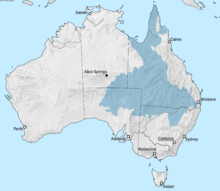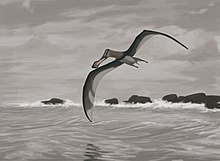South Polar region of the Cretaceous

The South Polar region of the Cretaceous comprised the continent of East Gondwana–modern day Australia,
The South Polar region housed many
Landscape
Geology

The Latady Basin in the southern Antarctic Peninsula–
An important fossil-bearing
The

The Eromanga Sea was an inland sea across what would be Australia that formed in the Early Cretaceous. The sea reached the Eromanga Basin from the north via the Carpentarian Basin. The southern end of the sea comprised lagoons and rivers, and to the east in Surat Basin a bay. When India drifted away from Australia in the Early Cretaceous, the Perth Basin also filled with seawater. The area that would be the Coral Sea was a rift valley. As Australia and Antarctica drifted apart throughout the Cretaceous, a sea formed in between them.[8]
Vegetation
The
Jurassic
The landscape of the
Early Cretaceous
In the

However, rocks from the Early Cretaceous
Late Cretaceous
The canopy of the polar forests around present-day Alexander Island, which was around 75°S in the Middle Cretaceous, were predominantly evergreen, and likely most South Polar forests were as well, and comprised mainly araucarian and podocarp conifers.[4][26][16] It is thought that these trees remained dormant throughout the polar winters until summers under the midnight sun.[27]
Evidence of flowering plants dating to around 80 Ma in the Late Cretaceous suggests the existence of temperate forests–similar to those in present-day Australia, New Zealand, and southern South America.[20] Some flower remains were discovered near 60°S, and it is possible at such a low latitude that this area was subject to polar winters and seasonal weather, though the flowers suggest an annual temperature range of 8–15 °C (46–59 °F) and a rainy climate.[16][18]
Pollen remains from southeastern Australia are identical to living plant species of Australia: conifers, flowering plants that inhabit areas with high rainfall and a
The Late Cretaceous (Campanian) Zamek and Half Three Point Formations of King George Island were located at 60°S and display a rich assemblage of fossil flora, such as Podocarpus; Araucaria; the leptosporangiate ferns Cladophlebis and Clavifera; and a variety of Magnoliopsida flowering plants, Dicotylophyllum, Myrciophyllum santacruzensis, Nothofagus, Sterculiaephyllum australis, Monimiophyllum, and so forth.[30][31][32] The Sobral Formation of Seymour Island spanning the Cretaceous–Paleogene boundary at a paleolatitude of 63°S provided a new genus of fossil flower in the family Cunoniaceae, Eucryphiaceoxylon eucryphioides.[33]
Ecology
Much as in Australia today, East Gondwana played host to many
Dinosaurs
Birds

The remains of the ancestor of modern birds, the
Two diving birds, possible primitive divers, were discovered in Late Cretaceous Chile and Antarctica: Neogaeornis and Polarornis. Polarornis may have been capable of both diving and flight.[36] The earliest penguins, Crossvallia and Waimanu, are known from 61–62 Ma in the Paleocene, however molecular data suggests penguins first evolved in the Late Cretaceous. Given that these penguins were dated so close to the Cretaceous–Paleogene extinction event, the group either evolved before the event or very rapidly afterwards.[36][37]
Non-avian
Dinosaur fossils are rare from the South Polar region, and major fossil-bearing locations are the
The supercontinent Pangaea of the Jurassic allowed major dinosaur clades to achieve a global distribution before breaking up, and several closely related cognates existed between South Polar forms and forms found elsewhere despite separation by the
The most common and diverse group found so far are the
Though remains are scant and, consequently, taxonomic descriptions can be dubious,

Four
Paleocene
After an
Rivers and lakes
The last
It is likely the temnospondyls inhabited the freshwater systems of polar Australia until the
Oceans

Early to Middle Cretaceous

Several Late Cretaceous oceanic plesiosaurs and mosasaurs have been discovered in New Zealand and Antarctica, with some, such as Mauisaurus, being endemic, while others, such as Prognathodon, having a cosmopolitan distribution.[54][55] Elasmosaurs and pliosaurs are known from one to three species from this area. The discovery of three cryptoclidids in the Southern Hemisphere–Morturneria from Antarctica, Aristonectes from South America, and Kaiwhekea from New Zealand–indicates a diversification of the family in the Late Cretaceous of this region and perhaps an increasing productivity of the early Southern Ocean.[56]
Pterosaurs

Two clades of pterosaurs are represented in Early Cretaceous Australia,
Of the Late Cretaceous pterosaurs, only the remains belonging to the family Azhdarchidae–found in the Carnarvon and Perth basins in Western Australia–were assigned to a taxon. A possible representative of Ornithocheiridae was found in Late Cretaceous Western Australia, though the family was previously thought to have gone extinct in the Early Cretaceous.[57][58][59]
Mammals

Seven mammals have been discovered from Early Cretaceous Australia: an undescribed
Invertebrates
Several fossils of
See also
- Dinosaur Cove
- Dinosaur Dreaming
- Geology of Antarctica, including paleontology
- List of Australian and Antarctic dinosaurs
- Gondwana Rainforests
- Polar forests of the Cretaceous
- "Spirits of the Ice Forest", episode 5 of Walking with Dinosaurs
References
- ISSN 0718-7106.
- USGS. Retrieved 14 March 2015.
- S2CID 129316703.
- ^ a b c Riffenburgh 2007, p. 72.
- ^ Riffenburgh 2007, p. 551.
- .
- ^ ISBN 978-0-520-24209-8.
- .
- ^ .
- PMID 27650167.
- PMID 12096745.
- doi:10.1130/G32733.1.
- .
- .
- .
- ^ S2CID 140637028.
- PMID 21625801.
- ^ .
- ^ JSTOR 24941547.
- ^ doi:10.1071/SB00022.
- ^ Constantine, A.; Chinsamy-Turan, A.; Rich, P. V.; Rich, T. (1998). "Periglacial environments and polar dinosaurs". South African Journal of Science. 94 (3): 137–141.
- S2CID 130306474.
- S2CID 128739024.
- ^ S2CID 130794388.
- .
- S2CID 129461955.
- ^ a b Riffenburgh 2007, p. 413.
- doi:10.1139/b91-116.
- .
- ^ Zamek Hill assemblage at Fossilworks.org
- ^ Skua Bay assemblage at Fossilworks.org
- ^ Half Three Point assemblage at Fossilworks.org
- ^ Sobral Formation at Fossilworks.org
- ^ )
- ^ Riffenburgh 2007, p. 146.
- ^ a b c d Tambussi, C.; Hospitaleche, C. A. (2007). "Antarctic birds (Neornithes) during the Cretaceous–Eocene time" (PDF). Revista de la Asociación Geológica. 62 (4): 604–617.
- S2CID 6472805.
- ^ PMID 22615916.
- ^ S2CID 28065814.
- S2CID 244799975.
- ISSN 2296-6463.
- CiteSeerX 10.1.1.546.3890.
- ^ ISBN 978-0-253-33773-3.
- .
- .
- ^ .
- PMID 21826250.
- .
- PMID 26713256.
- ^ PMID 27763598.
- .
- ^ .
- ^ .
- S2CID 128429649.
- .
- S2CID 129320404.
- ^ PMID 28480142.
- ^ S2CID 129915551.
- ^ S2CID 129729142.
- .
- S2CID 4342084.
- ^ Monro Conglomerate at Fossilworks.org
- ^ Swale Stream at Fossilworks.org
- ^ Waihere Bay, Pitt Island at Fossilworks.org
Further reading
- Riffenburgh, B. (2007). Encyclopedia of the Antarctic. Vol. 1. Taylor and Francis. ISBN 978-0-415-97024-2.
- Dutra, T. L.; Batten, D. J. (2000). "Upper Cretaceous floras of King George Island, West Antarctica, and their palaeoenvironmental and phytogeographic implications". Cretaceous Research. 21 (2–3): 181–209. .
- Filkorn, H. F. (1994). "Fossil scleractinian corals from James Ross Basin, Antarctica". Antarctic Research Series. 65: 1–96.
- Harris, A.C.; Raine, J.I. (2002). "A sclerite from a late Cretaceous moth (Insecta: Lepidoptera) from Rakaia Gorge, Canterbury, New Zealand". .
- Poole, I.; Mennega, A. M. W.; Cantrill, D.J. (2003). "Valdivian ecosystems in the Late Cretaceous and Early Tertiary of Antarctica: further evidence from myrtaceous and eucryphiaceous fossil wood". Review of Palaeobotany and Palynology. 124 (1–2): 9–27. S2CID 129281012.
- Rich, T. H. V. (2007). Polar Dinosaurs of Australia. Museum Victoria Nature Series. Museum Victoria. ISBN 978-0-9758370-2-3.
- Speden, I.A. (1973). "Distribution, stratigraphy and stratigraphic relationships of Cretaceous sediments, western Raukumara Peninsula, New Zealand". .
- Stilwell, J.D.; Vitacca, J.J.; Mays, C. (2016). "South polar greenhouse insects (Arthropoda: Insecta: Coleoptera) from the mid-Cretaceous Tupuangi Formation, Chatham Islands, eastern Zealandia". S2CID 130271909.
